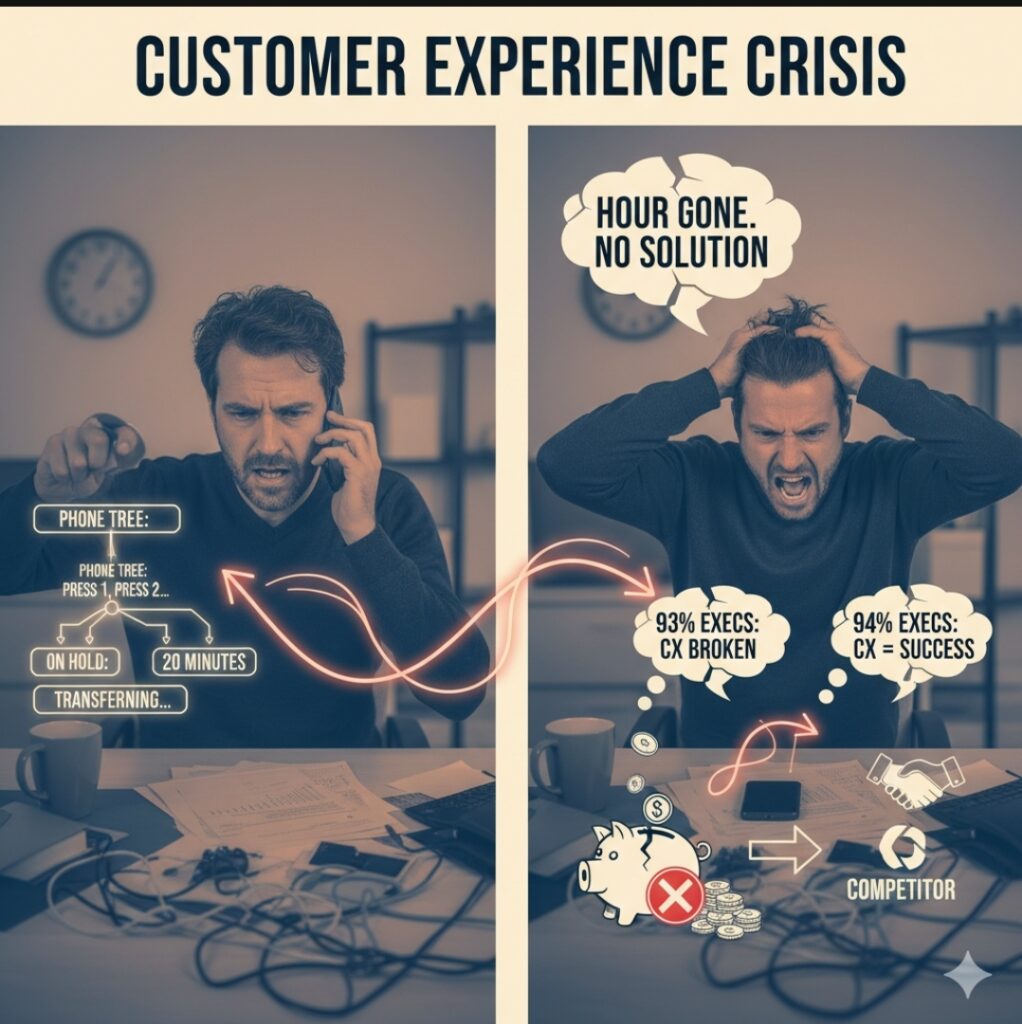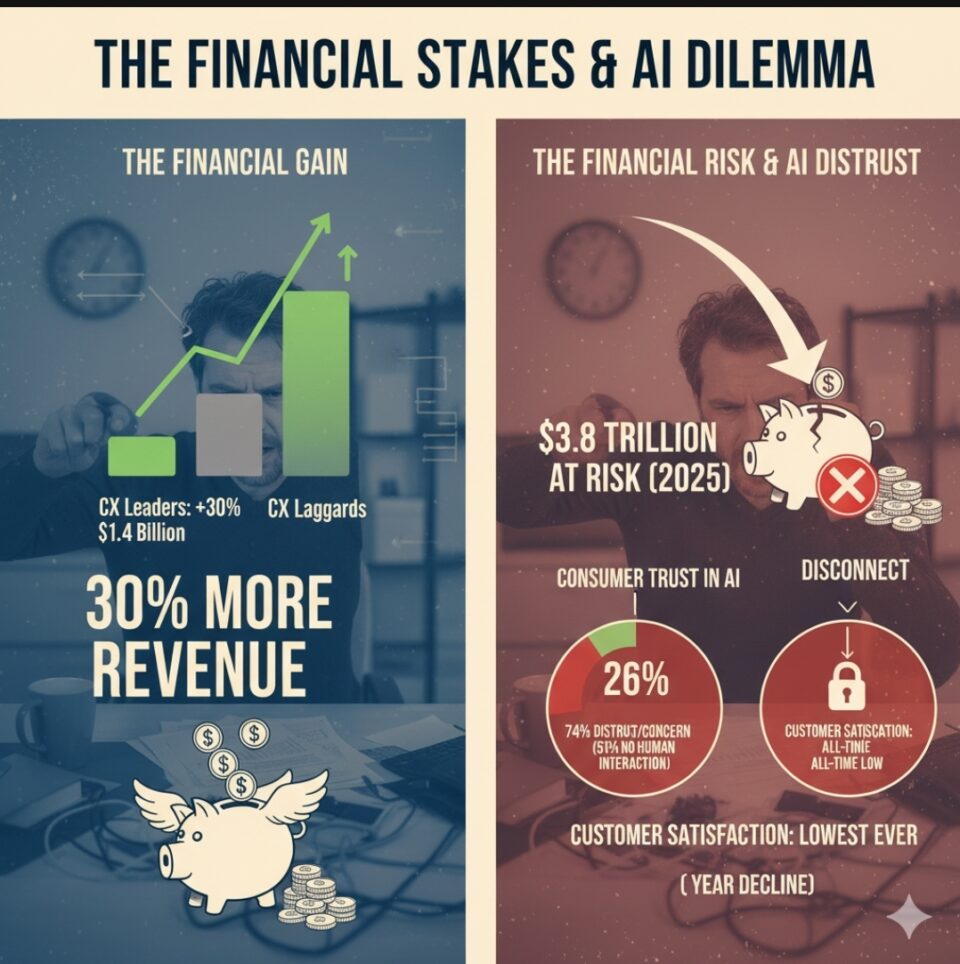93% of Executives Admit Their Customer Experience Is ‘Broken’ Meaning Disconnected Customer Experience
Picture this: You call your internet provider about a billing issue. After navigating a confusing phone tree, you wait 20 minutes on hold. The first agent transfers you without explanation. The second agent asks you to repeat everything you just explained. After an hour, you hang up frustrated—and still without a solution. This is a classic example of Disconnected Customer Experience.
Sound familiar? You’re not alone. A staggering 93% of C-suite executives now admit their customer experience is fundamentally “broken.”
This isn’t a minor hiccup in service delivery. This is a full-scale crisis and Disconnected Customer Experience that’s bleeding money, destroying trust, and driving customers straight to competitors. The irony? 94% of these same executives acknowledge that customer experience directly impacts business success.
The Staggering Cost of Broken CX
The financial stakes couldn’t be higher. Companies excelling at digital customer experience generate 30% more revenue—an average of $1.4 billion more than their CX laggards. Meanwhile, businesses globally risk losing $3.8 trillion in 2025 due to poor customer experiences.
These aren’t abstract numbers. They represent real customers walking away, real revenue vanishing, and real businesses failing to capture their potential. Even more alarming: only 26% of consumers currently trust organizations to use AI responsibly in customer service, while 51% express concerns about the absence of human interaction.
The disconnect is undeniable. Customer experience effectiveness has plummeted to its lowest point ever, marking three consecutive years of decline. Customer satisfaction levels have hit an all-time low despite increased corporate investment in CX improvements.
Why CX Transformation Is Failing
Leadership Misalignment Tops the List
Studies reveal three primary barriers destroying CX transformation efforts:
Leadership misalignment (49%) stands as the number one obstacle. When executives can’t agree on CX priorities, conflicting initiatives emerge across departments. Sales pushes for volume while customer service focuses on quality. Marketing promises features that product teams haven’t built. The result? Customers experience the chaos firsthand.
Creative talent shortages (44%) compound the problem. Organizations struggle to find professionals who understand both technology and human psychology—the dual expertise required for effective CX design.
Organizational silos (43%) create the third major barrier. These departmental kingdoms operate independently, making unified customer experiences nearly impossible to achieve.
The AI Implementation Gap Causing Disconnected Customer Experience
Despite heavy investment in artificial intelligence, 76% of C-suite respondents admit they’re behind on AI transformation. Even more concerning: 88% believe AI-driven personalization hasn’t reached its potential.
The problem isn’t technology—it’s implementation. Companies are deploying AI solutions without clear objectives, poor data quality, or inadequate integration with existing systems. Only 28% of executives are leveraging new technologies to create innovative or adaptive customer experiences.
Cultural Dysfunction Runs Deep
Perhaps most damaging of all: 56% of industry leaders cite cultural dysfunction as the primary barrier to CX success. This cultural breakdown manifests in several destructive ways:
Score-begging behavior: Front-line employees pressure customers for high ratings instead of focusing on actual problem resolution.
Scripted interactions: Customer service agents rely on inflexible scripts that prevent empathetic, personalized responses.
Metric obsession: Organizations focus on survey data and dashboards while ignoring actual customer stories and feedback.
The Human Cost of Digital-First Strategies
The rush toward automation has created unexpected consequences. While companies invested heavily in chatbots and self-service options, they overlooked a fundamental truth: customers still crave human connection.
Only 19% of consumers feel they can immediately access assistance from a live person. When they do reach human agents, customers predominantly perceive them as disengaged and unhelpful. This absence of personal touch has become a significant pain point, with 52% of respondents identifying difficulty in reaching a live agent as their primary complaint.
The chatbot revolution has backfired spectacularly. Only 17% of customers have confidence in the effectiveness of chatbots or web self-service interactions. Instead of solving problems, these tools often serve as obstacles to reaching human representatives.
The Omnichannel Illusion in Disconnected Customer Experience
Companies proudly tout their omnichannel capabilities, but the reality tells a different story. Three critical flaws plague current approaches:
Inadequate channel guidance: Brands expand their omnichannel options but fail to direct customers to the most effective channel for their specific needs. This leads to suboptimal channel selection and customer frustration.
High-effort digital experiences: Many digital platforms place undue burdens on customers, requiring significant effort to accomplish tasks that could be streamlined. When exceptions arise, customers must restart processes from scratch with human agents.
Fragmented data: When departments and channels don’t share customer information, experiences become fragmented and frustrating. Customers repeatedly re-enter information and explain their situations to multiple representatives.
Breaking Down the Silos
Organizational silos represent the silent killer of customer experience. These departmental kingdoms create nightmares for customers who expect seamless, connected experiences.
The impact extends beyond customer frustration. Silos kill innovation, waste resources, reduce employee morale, and make omnichannel experiences impossible. When sales, marketing, customer service, IT, and finance operate independently, customers pay the price through disjointed interactions.
The Path Forward: Actionable Solutions to Win Over Disconnected Customer Experience
1. Align Leadership Around Common Goals
Create meaningful, customer-centric goals that every department can connect to. Replace departmental metrics with cross-functional measures like Net Promoter Score that force collaboration.
Ricoh Canada demonstrated this approach successfully, introducing an organization-wide NPS goal that required every department—including Finance and Legal—to contribute to improving the score. The result: a 30-point jump in NPS and increased sales in a declining market.
2. Fix Compensation and Incentive Structures
Stop compensating employees based on CX scores. Instead, focus on operational metrics that result from providing exceptional experiences: repeat business, sales growth, and earned growth.
Hire employees who are genuinely excited about delivering exceptional customer experiences. When people are intrinsically motivated to serve, business outcomes naturally follow.
3. Humanize Technology Implementation
Use AI to enhance human capabilities, not replace them. The most successful organizations utilize AI to engage with customers, manage customer lifecycles, and elevate human experiences—not simply automate processes.
Implement clear objectives before deploying AI solutions. Define specific, measurable goals aligned with enhancing customer experience, whether reducing response time, personalizing interactions, or improving product recommendations.
4. Build Cross-Functional Customer Journey Teams
Run cross-functional projects that eliminate “us versus them” thinking. Bring together representatives from every department that touches the customer experience. Map entire customer journeys, identify pain points, and assign ownership for improvements.
These teams should focus on customer stories, not just survey data. Discuss what worked well, what didn’t work well, and how issues were resolved or escalated.
5. Democratize Customer Data
Share customer feedback and metrics across the entire organization. Give employees at all levels access to customer insights, creating a culture of customer-centricity. When everyone from frontline staff to the C-suite understands how their work impacts customers, real change happens.
Provide frontline employees with key themes from open-ended feedback and sentiment analysis, rather than just scores. Use customer stories to bring experiences to life and drive empathetic responses.
6. Implement Continuous Feedback Loops
Move beyond periodic NPS surveys to create ongoing dialogue with customers. Use conversational approaches that demonstrate genuine care for customer input. Consider personal video messages from senior leadership asking for feedback, conversational SMS outreach, or on-site feedback mechanisms.
Most importantly, close the loop. Follow up with customers to show how their feedback drove improvements. This demonstrates that their voice matters and encourages future engagement.
7. Focus on Employee Experience
Remember that employees who feel valued create exceptional customer experiences. Invest in comprehensive training, provide necessary tools and authority to resolve issues, and create a culture that celebrates customer success stories.
Cross-train agents to handle different query types, reducing transfers between departments. Equip teams with unified knowledge management systems that provide full visibility into past customer interactions.

The Urgency of Now
The 93% of executives admitting their CX is broken represent more than a statistic—they represent a wake-up call. Customer loyalty is declining faster than ever, with 63% of customers willing to switch providers after just one or two negative experiences.
The companies that act decisively on CX transformation will capture disproportionate market share. Those that continue with broken approaches will watch customers and revenue disappear to more customer-centric competitors.
The choice is clear: Fix your customer experience now, or watch your business become another casualty in the CX crisis engulfing corporate America.
The transformation starts with leadership alignment, continues through employee empowerment, and succeeds through relentless focus on customer outcomes over internal metrics. The 93% who admit their CX is broken have taken the first step. The question is: What happens next?


